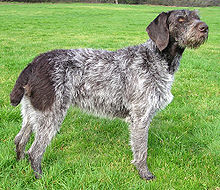German Wirehaired Pointer
| German Wirehaired Pointer | |||||||||||||
|---|---|---|---|---|---|---|---|---|---|---|---|---|---|
 German Wirehaired Pointer | |||||||||||||
| Other names | Deutsch Drahthaar Deutscher Drahthaariger Vorstehhund Drahthaar | ||||||||||||
| Origin | Germany | ||||||||||||
| |||||||||||||
| Dog (domestic dog) | |||||||||||||
The German Wirehaired Pointer is a medium to large-sized griffon type breed of dog developed in the 19th century in Germany for versatile hunting. It became a leading gun dog in Germany in the later part of the 20th century. It is the result of the careful mixing and crossing of the Wirehaired Pointing Griffon, German Shorthaired Pointer, German Roughhaired Pointer, and the hunting Pudelpointer in the late 19th century.
History
[edit]This section needs additional citations for verification. (April 2019) |
The German Wirehaired Pointer traces its origins back to 1880. The breed originated in Germany, where Baron Sigismund von Zedlitz und Neukirch was a leading breeder,[1] wanting to create a versatile hunting dog that would work closely with either one person or a small party of persons hunting on foot in varied terrain; from the mountainous regions of the Alps, to dense forests, to more open areas with farms and small towns. The breed the Germans desired had to have a coat that would protect the dogs when working in heavy cover or in cold water, yet be easy to maintain. Careful crosses of the German pointer with many other breeds. Sources differ on the exact lineage, though the Wirehaired Pointing Griffon, Pudelpointer, Stichelhaar, and Deutscher-Kurzhaar are commonly accepted as the most likely contributors. This is a dog that can fully respond to the needs of its hunter. The goal was to develop a wire-coated, medium-sized dog that could:
- Search for, locate and point upland game
- Work both feather and fur with equal skill and retrieve water fowl
- Be a close-working, easily trained gun dog
- Be able to track and locate wounded game
- Be fearless when hunting "sharp" game such as fox
- Be a devoted companion and pet; and
- Be a watchdog for its owner's family and property.
All "drahts" must meet rigorous hunt and physical evaluations before being eligible for breeding. In addition to searching and pointing, these tests include the tracking and recovery of all game including wounded game such as fox, rabbit, deer and boar, which may not be required of a dog that hunts birds predominantly.
For upland (i.e. non-waterfowl) bird work, many GWPs have distinguished themselves with all-breed Field Championships and Master Hunter titles. When purchasing a working GWP, attention needs to be paid to identifying breeders that place emphasis on all aspects of the versatile hunting dog. Among these breeders can be found accomplished dogs including Dual Championships (both field and show).
Description
[edit]Appearance
[edit]
The German Wirehaired Pointer is a well muscled, medium to large-sized dog of distinctive appearance. Balanced in size and sturdily built, the breed's most distinguishing characteristics are its weather resistant, wire-like coat and its facial furnishings. Typically pointer in character and style, the German Wirehaired Pointer (GWP) is an intelligent, energetic and determined hunter. The tail is typically docked to two-fifths of the natural length. In countries where docking is prohibited the tail should be of sufficient length to reach down to the hocks. Like all German pointers, they have webbed feet. This dog can have a similar appearance and therefore is sometimes confused with the Spinone Italiano, Český Fousek, or Wirehaired Pointing Griffon.[citation needed]
Coat
[edit]The functional wiry coat is the breed's most distinctive feature. A dog must have a correct coat to be of correct type. The coat is weather resistant and water-repellent. The undercoat is dense enough in winter to insulate against the cold but is so thin in summer as to be almost invisible. The distinctive outer coat is straight, harsh, wiry and flat lying, and is from one to two inches in length. The outer coat is long enough to protect against the punishment of rough cover, but not so long as to hide the outline of the dog. On the lower legs the coat is shorter and between the toes it is of softer texture. On the skull the coat is naturally short and close fitting. Over the shoulders and around the tail it is very dense and heavy. The tail is nicely coated, particularly on the underside, but devoid of feather. Eyebrows are of strong, straight hair. Beard and whiskers are medium length. The hairs in the liver patches of a liver and white dog may be shorter than the white hairs. A short smooth coat, a soft woolly coat, or an excessively long coat is to be severely penalized when showing. While maintaining a harsh, wiry texture, the puppy coat may be shorter than that of an adult coat. The coat of the puppy should be shorter than 1 inch the adult coat should be kept at 1 inch long.
Gait
[edit]The dog should be evaluated at a moderate gait. The breed standard is that the movement is free and smooth with good reach in the forequarters and good driving power in the hindquarters. The topline should remain firm.

Color
[edit]The colors are liver (brown) and white or black and white ticked usually with some solid patches, and solid liver (brown) with or without a white chest patch.[2]
Health
[edit]A 2024 UK study found a life expectancy of 13 years for the breed compared to an average of 12.7 for purebreeds and 12 for crossbreeds.[3]
References
[edit]- ^ Hörter, Ria (3 April 2020). "Ria Hörter, Dog Writer, Creators of Pedigree Dogs". riahorter.com. Retrieved 2020-04-03.
- ^ "German Wirehaired Pointer Breed Standard". American Kennel Club. 2007. Retrieved 2012-10-15.
- ^ McMillan, Kirsten M.; Bielby, Jon; Williams, Carys L.; Upjohn, Melissa M.; Casey, Rachel A.; Christley, Robert M. (2024-02-01). "Longevity of companion dog breeds: those at risk from early death". Scientific Reports. 14 (1). Springer Science and Business Media LLC. doi:10.1038/s41598-023-50458-w. ISSN 2045-2322. PMC 10834484.
